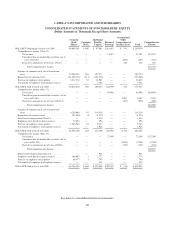Cabela's 2005 Annual Report Download - page 70
Download and view the complete annual report
Please find page 70 of the 2005 Cabela's annual report below. You can navigate through the pages in the report by either clicking on the pages listed below, or by using the keyword search tool below to find specific information within the annual report.loan principal. The other assumptions and estimates we use in estimating the fair value of the interest-only strip
receivable include projected loan payment rates, which are used to determine the estimated life of the securitized
loan principal, and an appropriate discount rate.
The assumptions and estimates used to estimate the fair value of the interest-only strip receivable at each
reporting period reflects management’s judgment as to the expected excess spread to be earned and payment
rates to be experienced on the securitized loans. These estimates are likely to change in the future, as the
individual components of the excess spread and payment rates are sensitive to market and economic conditions.
For example, the rates paid to investors in our securitization transactions are primarily variable rates subject to
change based on changes in market interest rates. Changes in market interest rates can also affect the projected
interest income on securitized loans, as we could reprice the portfolio as a result of changes in market conditions.
Credit loss projections could change in the future based on changes in the credit quality of the securitized loans,
our account management and collection practices, and general economic conditions. Payment rates could
fluctuate based on general economic conditions and competition. Actual and expected changes in these factors
may result in future estimates of the excess spread and payment rates being materially different from the
estimates used in the periods covered by this report.
On a quarterly basis, we review and adjust as appropriate, the assumptions and estimates used in
determining the fair value of the interest-only strip receivable recognized in connection with our securitization
transactions. If these assumptions change, or actual results differ from projected results, the interest-only strip
receivable and securitization income would be affected. If management had made different assumptions for the
periods covered by this report that raised or lowered the excess spread or payment rate, our financial position and
results of operations could have differed materially.
Note 2 to our audited consolidated financial statements provides further detail regarding the assumptions
and estimates used in determining the fair value of the interest-only strip receivable and their sensitivities to
adverse changes.
Impact of Recent Accounting Pronouncements
On December 16, 2004, the FASB issued Statement No. 123 (revised 2004), “Share-Based Payment”
(“Statement 123R”). Statement 123R requires us to recognize compensation expense for stock options and
discounts under employee stock purchase plans granted to employees based on the estimated fair value of the
equity instrument at the time of the grant. Currently we disclose the pro forma net income and earnings per share
as if we applied the fair value recognition provisions of Statement 123 as amended by Statement 148. The
requirements of Statement 123R are effective for us beginning January 1, 2006. Under the Modified Prospective
Method, we will recognize compensation expense for equity awards issued after January 1, 2006 on a straight-
line basis over the requisite service period for the entire award. We also expect to record expense of
approximately $2.3 million in fiscal 2006 and $1.5 million in fiscal 2007 related to previously-issued, unvested
and outstanding stock options that were granted after our initial public filing. We will continue to utilize the
Black Scholes model in calculating estimated fair value of stock options. On March 29, 2005, the SEC issued
Staff Accounting Bulletin No. 107 (“SAB 107”). SAB 107 provides interpretations expressing the views of the
SEC staff regarding the interaction between Statement 123R and certain SEC rules and regulations, and provides
the staff’s views regarding the valuation of share-based payment arrangements for public companies. SAB 107
does not modify any of the conclusions or requirements of Statement 123R. On November 10, 2005, the FASB
issued FSP FAS 123R-3 which “Provides a Transition Election for Calculating the APIC Pool Under Statement
123R.” Statement 123R APIC Pool—Statement 123R requires companies to calculate the pool of excess tax
benefits available to absorb tax deficiencies recognized subsequent to the adoption of Statement 123R (the
“APIC pool”). In calculating the APIC pool, we must include the net excess tax benefits as if we originally
adopted Statement 123 for recognition purposes. Many companies have indicated that they do not have, and may
not be able to re-create, such information. Accordingly, the FASB issued FSP FAS 123R-3 to provide an elective
58
























